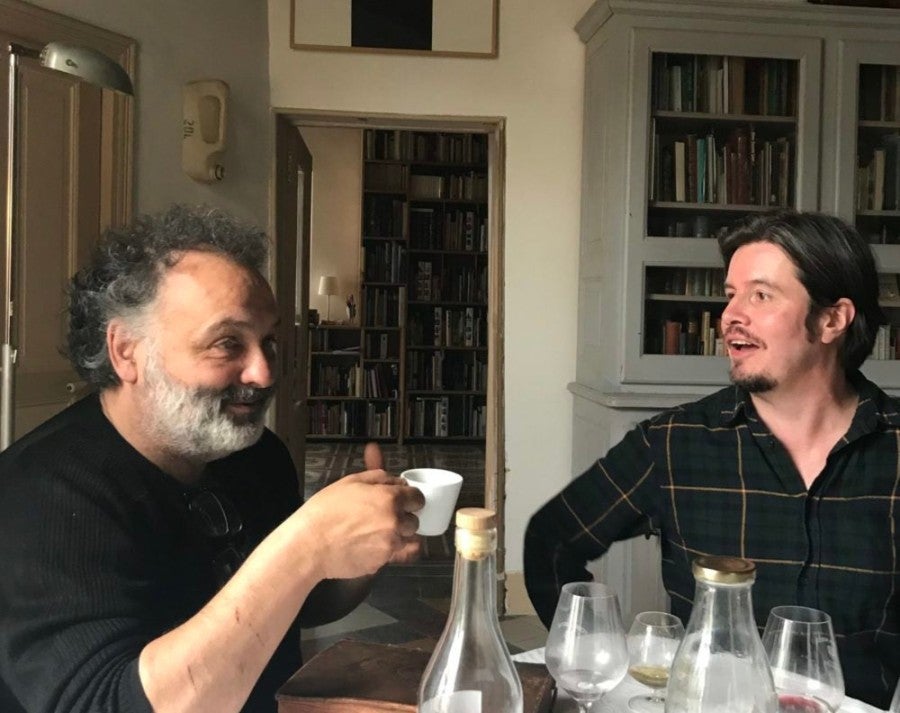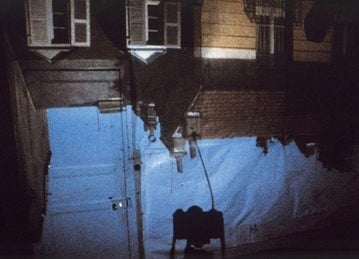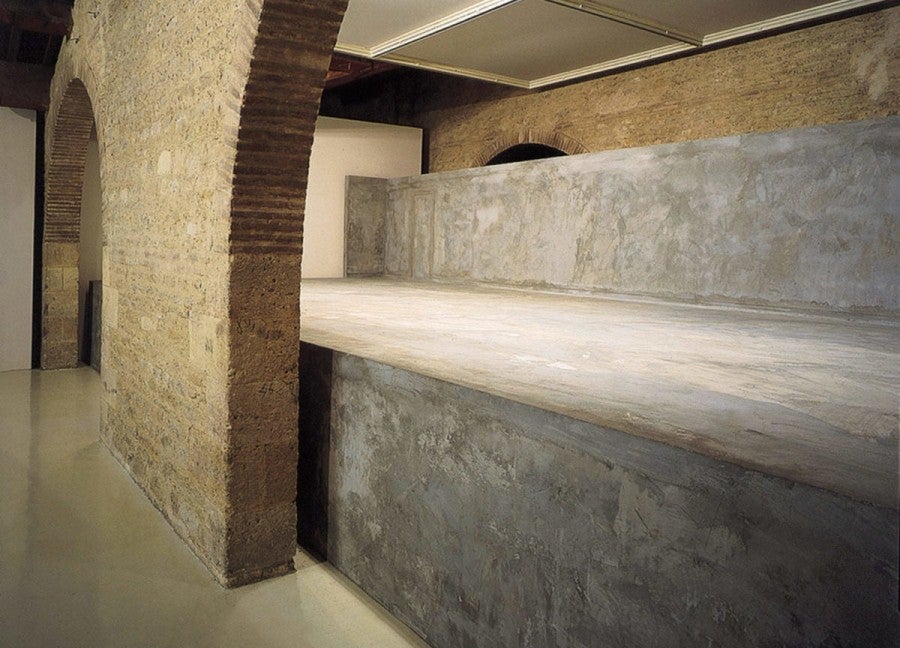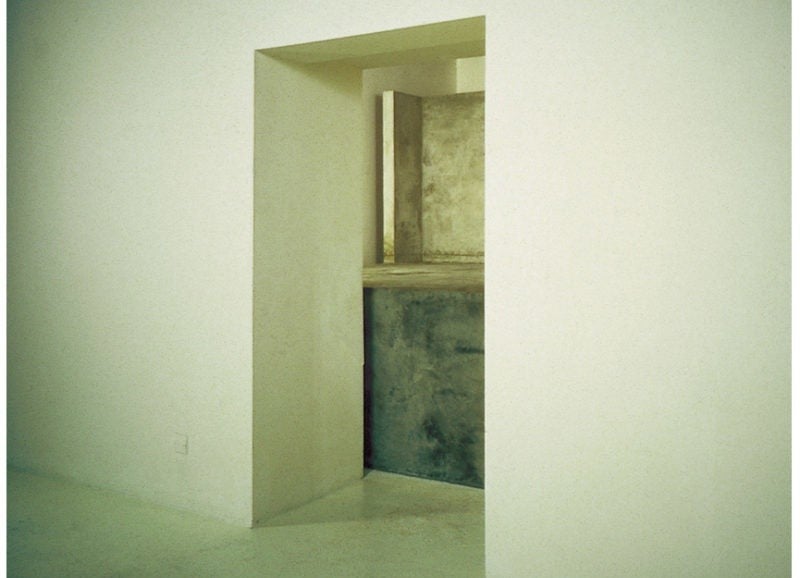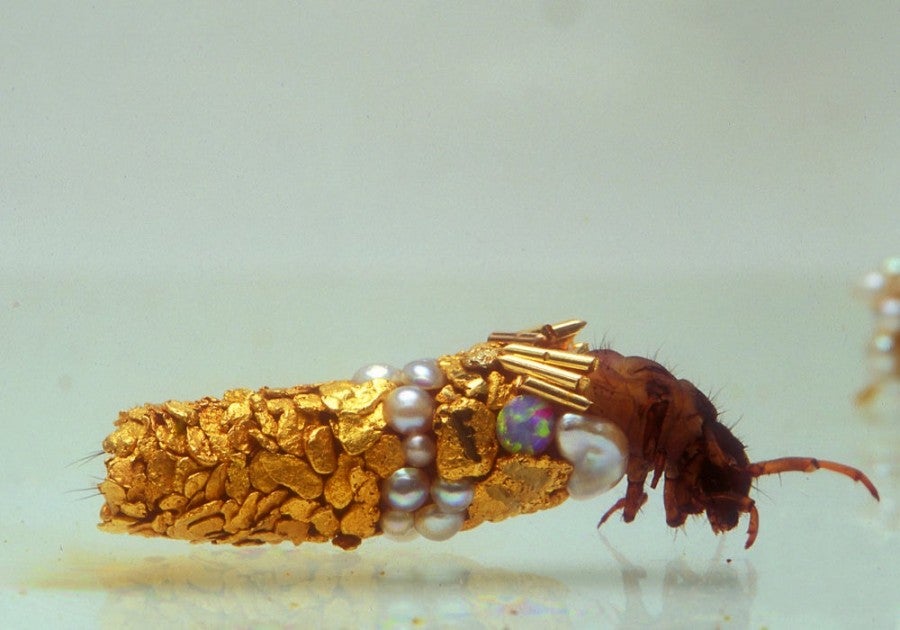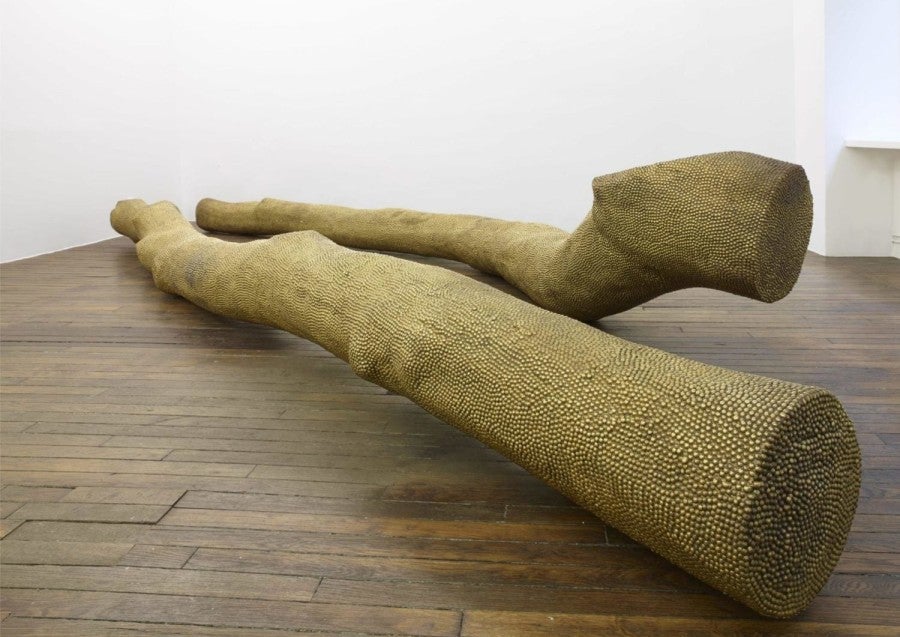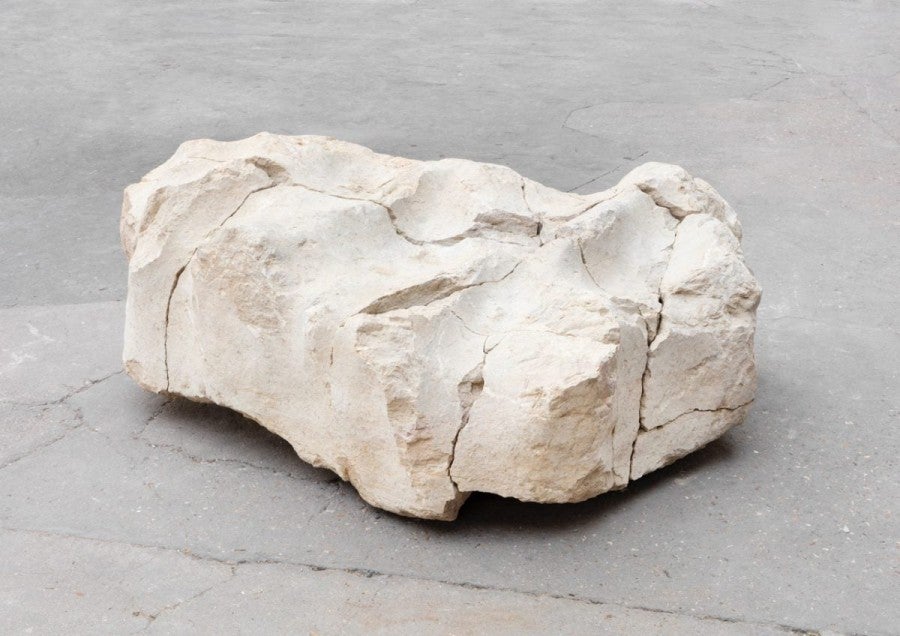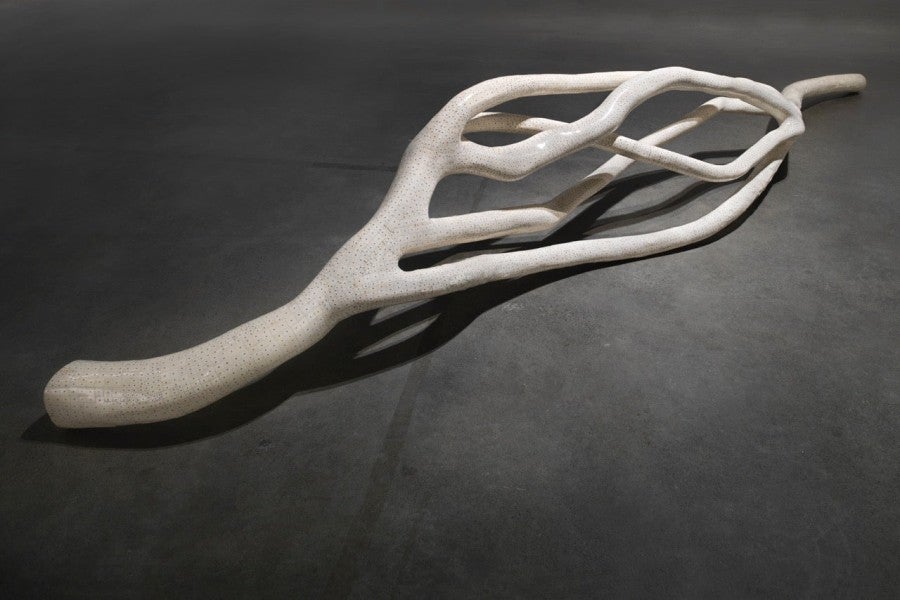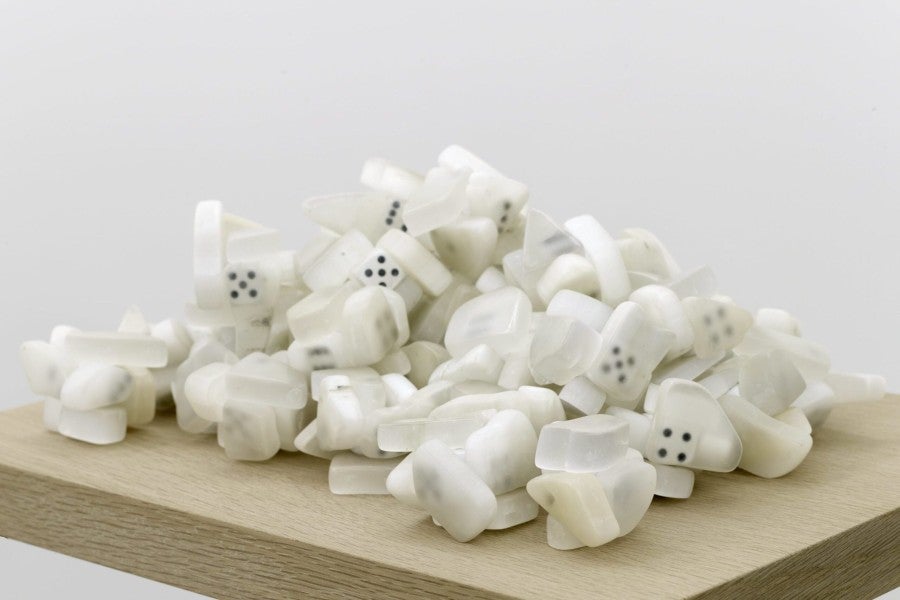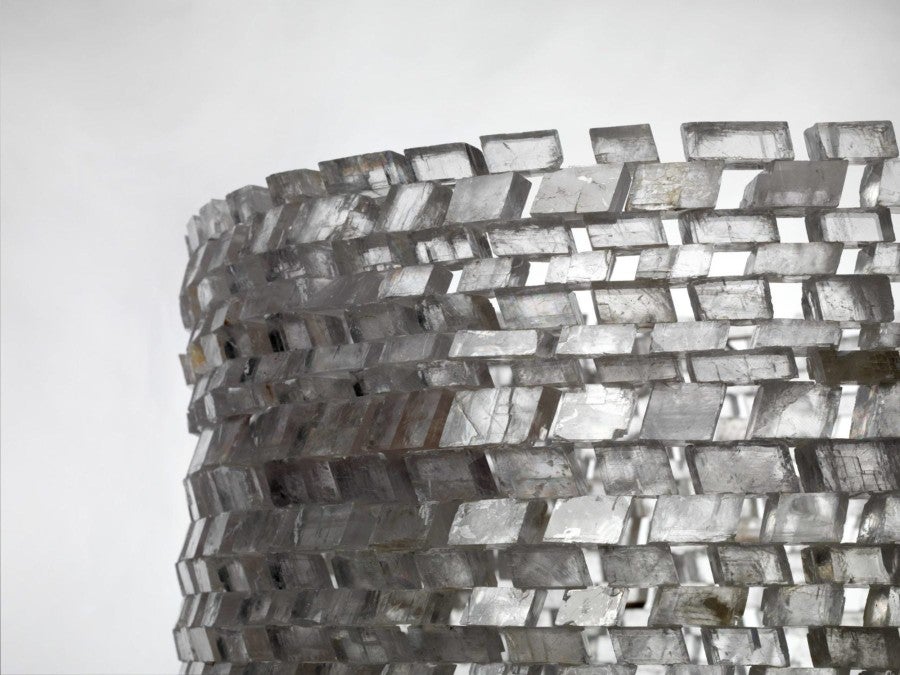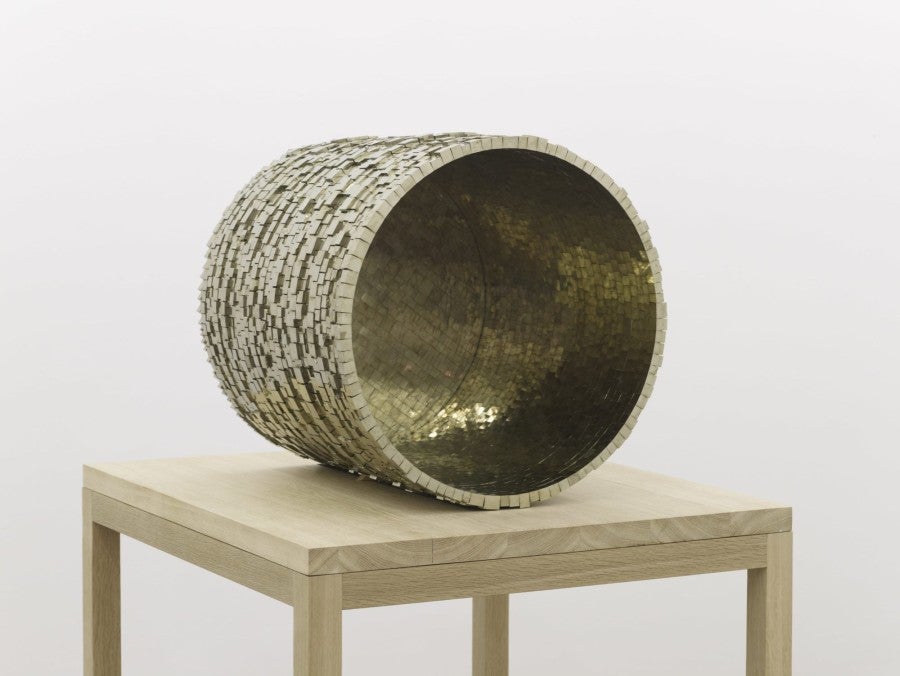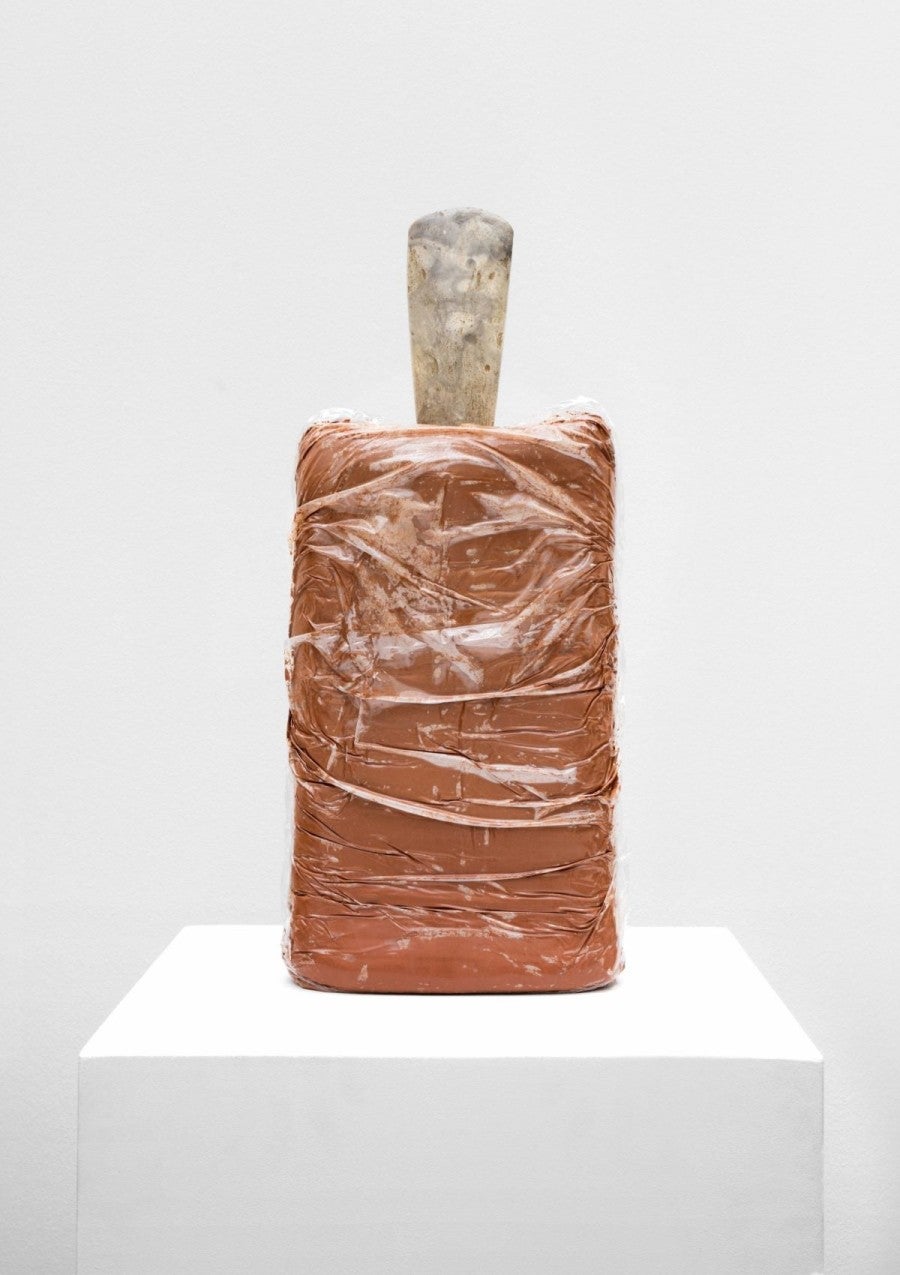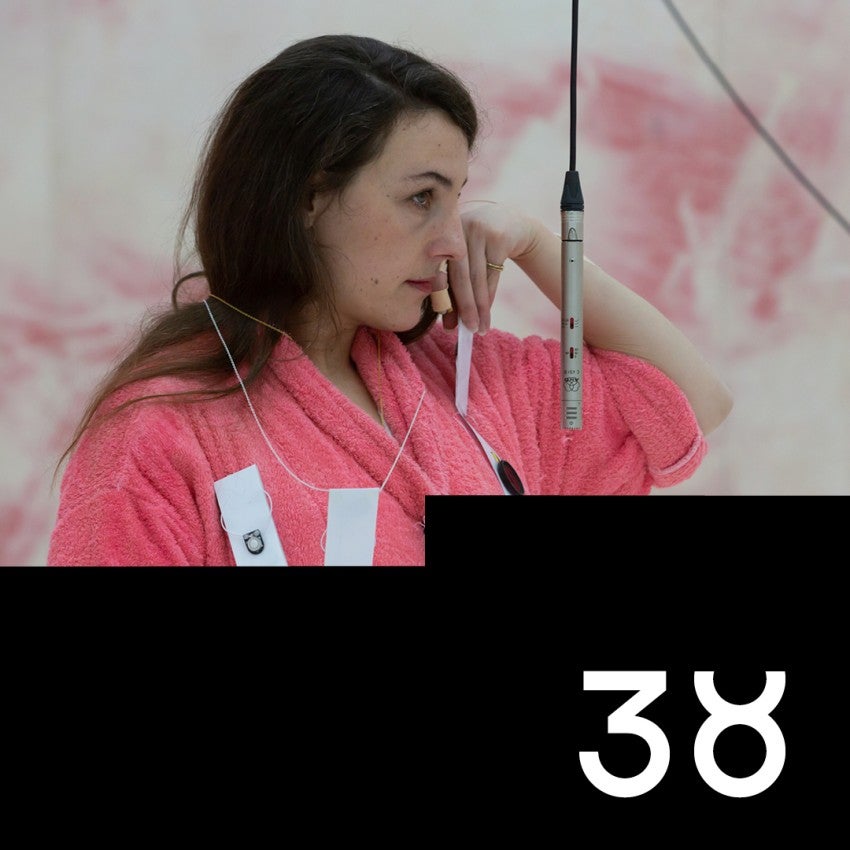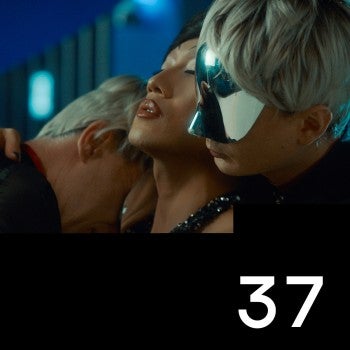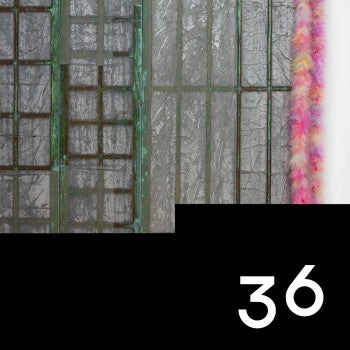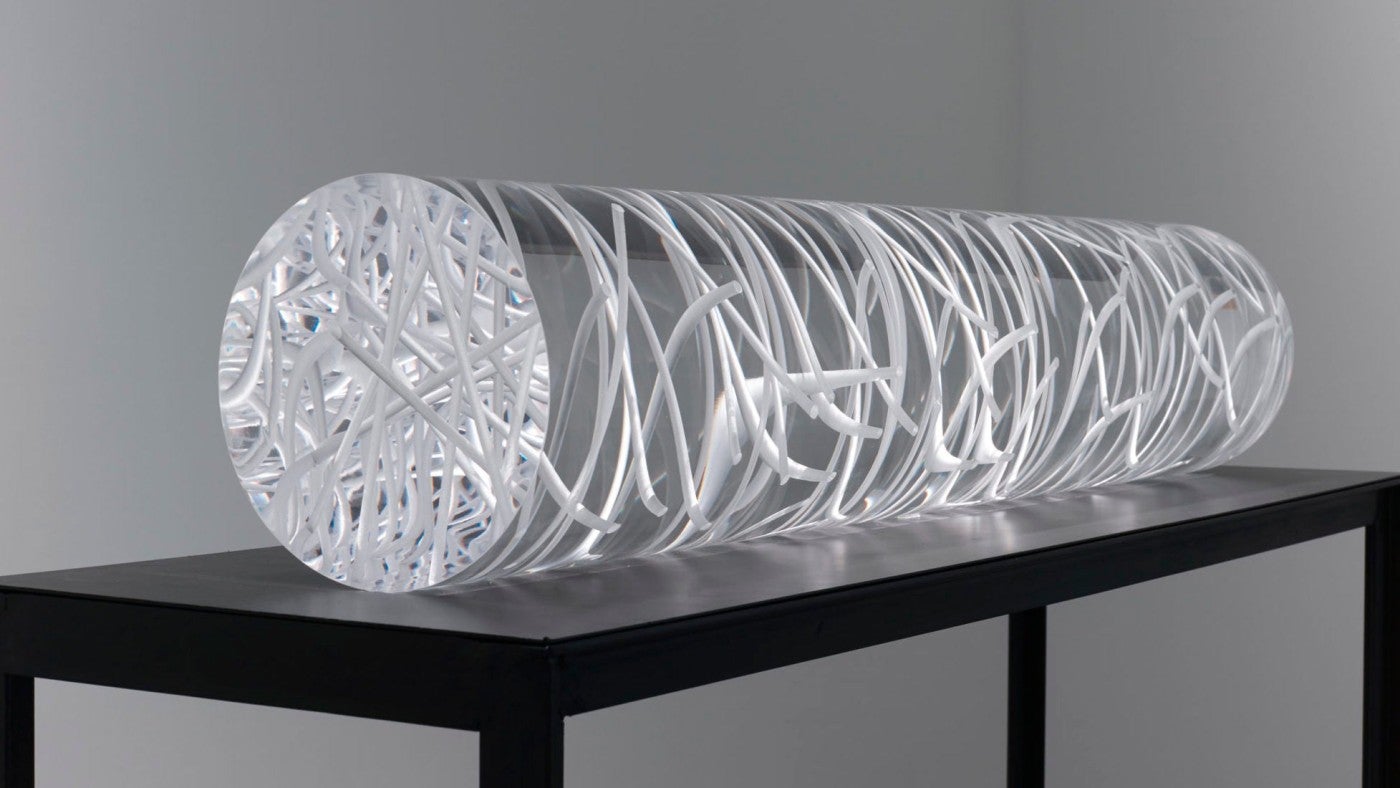
1.
...at once a record of its own making and a precise ambiguity
I recently encountered two large untitled marquetry works by Hubert Duprat, dating from 2001. One featured an undulating shape, a wavy stack of sawn curves in brown shades of Indian ink-stained plywood; the other, made the same way, looked something like a self-contained burst of pointy flame. Both, it turns out, draw their iconography from the Apocalypse Tapestry (1377–82) in the Château d’Angers, in the Loire Valley, a work that was in turn based on the Book of Revelations. It’s tempting, given the preponderance of narrative in contemporary art, to seize upon the latter fact as a key to the taciturn semi-abstractions here, inflate its importance and align these works with some foreboding narrative about the end of the world. Let’s not, though, because Duprat is not a storytelling artist. Or, rather, any storylines you might pick up are peripheral dazzle rather than central to his aims.
For example, these works were part of an exhibition of Duprat’s in Paris, and another work in the same show might have seemed to amplify airborne religious connotations by being titled Martyr (2019). It comprises, however, a transparent polymethyl methacrylate (often referred to as Plexiglas) tube appearing to contain a multiplicity of white tubes. Look at it from the end, where you get a circular viewpoint undistorted by curvature, and these lines read as straight. View it from the side and they bend and weave. Zoom in, puzzled, and you might realise that these are not solid, enclosed objects at all but holes, the result of cleanly drilling into the plastic in many directions. (At a poetic stretch, one might think of the vulnerable torso of St Sebastian, though a ‘martyr’ is also a term for a piece of wood used to protect a workbench during cutting or drilling.) The abrasions left by the drill create the illusion of objecthood, just as the cutting of marquetry establishes form. In this optically vibrational work, then, whose associativity and ever-shifting composition makes you prowl pleasurably around it, composing is synonymous with sheer precision-tooled gesture. It’s an intercession in the void, a bit like—to nod to a series of Duprat’s photographs—an astronaut on a spacewalk. The clear plastic, and the plywood too, are default voids. The art, as much as anything, is a record of a physical intervention that creates visual intrigue, sets in motion sustained looking, then circles back to its own materiality. (In the two untitled works, the flames and waves do the same.) These lines were carefully bored or cut and where there was nothing, the art says, now there’s this, at once a record of its own making and a precise ambiguity: a riddle without a key, already suggesting that the art might be hermetic, concerned with art itself, which in a sidelong way it is.
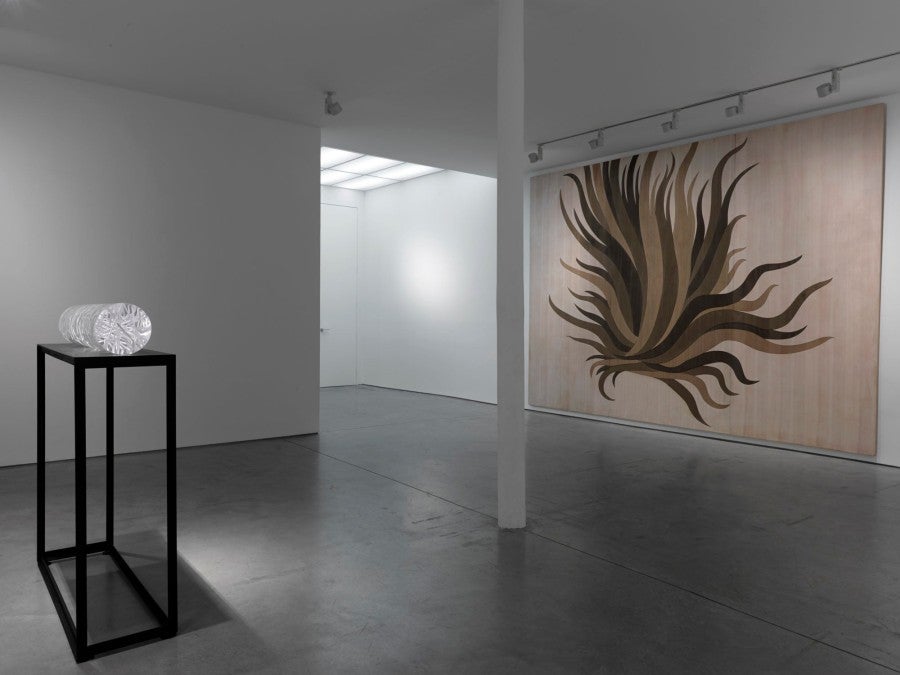
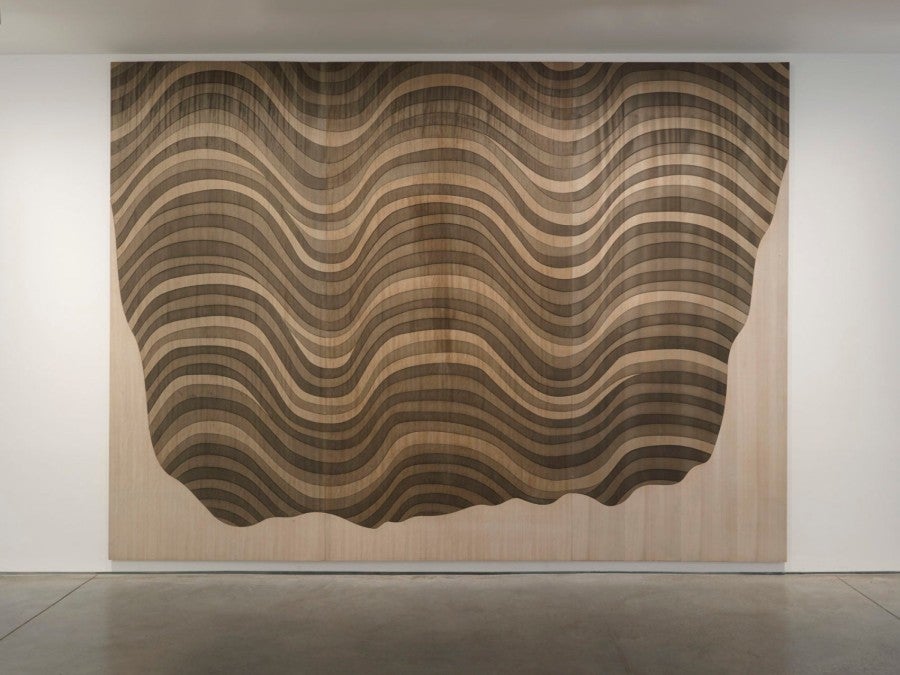
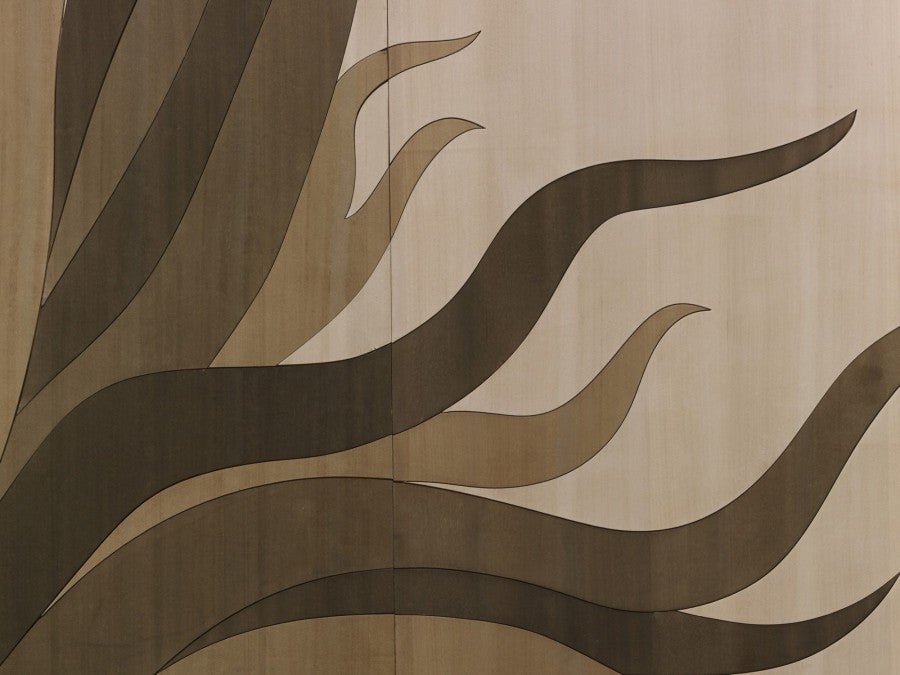
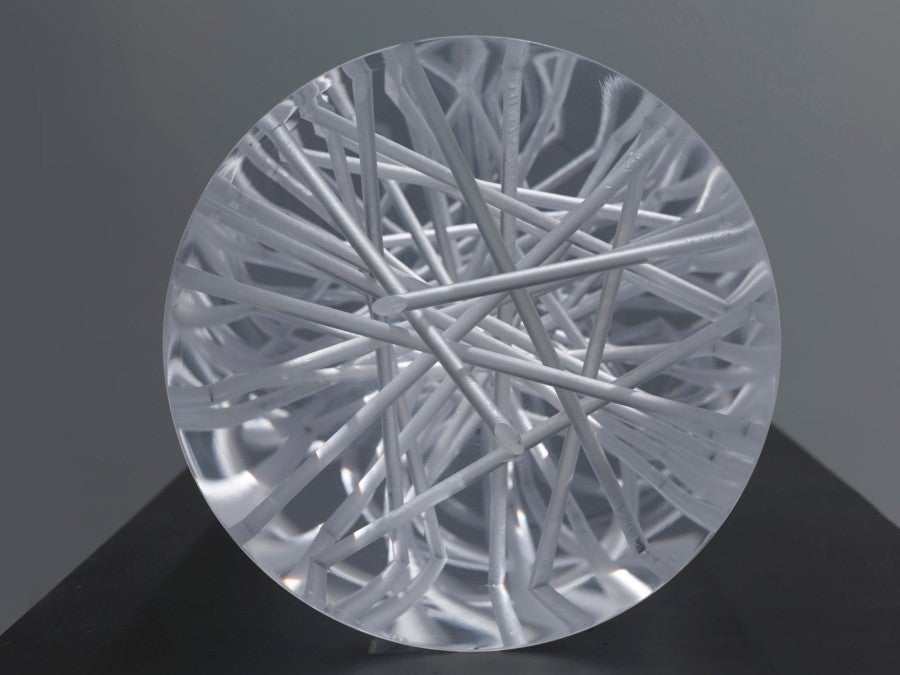
When I visited the exhibition, Duprat had been considering adding one more work midway through, a sculpture relating to a long-running continuum of pieces modelling or reflecting the artist’s studio. (As his decision to exhibit a pair of earlier artworks in one of his rare commercial-gallery shows might demonstrate, he steers by his own compass in these matters. Indeed, in many ways of which the uniqueness of his practice is just one part, Duprat is an outsider in the art world, resistant to producing to order and tough to affiliate with other practitioners.) Anyway, the notion of adding a studio-related work had a logic of its own. Duprat essentially began his career, in the early 1980s, with works that circularly served to depict a studio space (specifically, and less glamorously, his apartment at the time in Pau), or to pull the chancy world just outside the studio into it and then represent it. Initially he used a camera obscura, having found the world outside projected on his wall thanks to a pinhole in a cardboard sheet blacking out his window, and took the series of Cibachromes L’Atelier ou la montée des images (1983–5). Then he moved onto marquetry inlaid with rarefied materials that continued to map the contours of his workspace; and then sculpture in which he reconstructed his room in other spaces, sometimes in epic expanses of concrete. In the early postmodernist period, such works appeared to ruminate on available space: they were gestures that called attention to the constrained legroom in which they operated.
Who is the creator of Duprat’s caddisfly works, he or they, or both?
At the same time, however, Duprat inaugurated another, major, body of work: his ongoing collaboration with caddisfly larvae. These insects, concerning which he has amassed a huge library of reference works, build casings around themselves from whatever’s to hand. The artist, in a self-designed process he later patented, gave them the materials to make something valuable by default: gold flakes and precious gems, e.g. opal, turquoise, etc. In his works concerned directly with the studio environment and in his caddisfly collaborations, then, Duprat conflates artwork with habitat. If you have nothing more than that, a designated near-emptiness, then maybe you can see the value of an intercession in raw terms; or see it as a question pertaining to artistic value, which this artist tends to programmatically jeopardise. Who is the creator of Duprat’s caddisfly works, he or they, or both? And what—to return to apocalypses, given that declining insect populations, and their centrality to our ecosphere, are much in the news—is the present value of any ecological discussion here? One answer, despite Duprat having said (to me personally, and to others in print) that his work is melancholic, is this: handwringing is of less value than Duprat’s overlapping of the category of visual art with all kinds of other material operations, past and present, human and otherwise.
2.
In the early ‘90s Duprat made Coupé-Cloué (Cut-Nailed, 1991–2), in which some 70,000 upholsterer’s nails were driven into five tree trunks, creating a shimmering hybrid of the natural and the cultural. (As Maurice Fréchuret has pointed out1, these appliqued objects are in conversation with the caddisfly sheathes; so, seemingly, is Martyr.) In his related Cassé-Collé (Broken-Glued, 1991–4) works, Duprat split limestone boulders repeatedly with a pneumatic drill and then glued them back together, their seams highly visible. This work exists on a continuum with museum restoration in the same way that Coupé-Cloué does with upholstery and the marquetry works do with the selfsame craft tradition. They flatten hierarchies, in other words, drawing vitality from practices that do not pretend to be art (and some of them by purely instinctual creatures who are not conscious that they are making anything except a shelter).
In this way Duprat locates wiggle room within the closed environs of sculptural practice in particular, and subtly requests a transvaluing that extends across time and space. ‘Art’, here, becomes an expanded field in itself. It becomes synonymous, again, with the constructive gesture in a void, whoever or whatever makes it. As such, this expansive category can encompass a centuries-old tapestry, the utterly ancient insectoid practice of building shelter, or cultural acts of adornment, or glorification. One could characterise the caddisfly’s actions, under Duprat’s supervision, as such. One could say the same of Corail Costa Brava (1994–8), in which he wrapped rings of bread—humble, widely available stuff—around a rhizomatic, brain-like, red Mediterranean coral, polished by Neapolitan coral-carvers, the result looking like something from an ethnological museum (and also like art). Here the rarefied category of ‘contemporary art’ is itself drilled open and resealed, slightly differently, the process left visible. So much of what Duprat does involves a real or an invented manner of taking a natural material and skilfully jazzing it up, and this is often what, as a species, we do to the world: when the specific reasons are sheared off, it all starts to look like one big practice for which we’ve historically found many, many names. Assayed whole, his oeuvre starts to resemble a stream of cultic artefacts from a tribe that crosses all lines of time, space and biology.
Take the sculptural installation Chagrin (2014), for example. It’s an imposing white structure that harks back to geometric modernism, to the autonomous dealings of early 20th-century art. But there is a rogue element in it, which its title points towards: shagreen (from which English word the French title comes), ray-skin or shark-skin, rectangles of which appear to staple the white object together and which require expert, traditional craftsmanship, such that the work spans the timeframe between the handmade and artisanal and the industrial modern, or rather collapses them together. Coupé-Cloué, too, feels faintly like it could have been transposed from a dimly lit corner of the Musée du quai Branly, but at the same time recalls arte povera. And the Untitled works outlined at this text’s outset unite imagery from the 12th century, a longstanding tradition of inlaying that goes back to Ancient Rome and, in one case, a wavering, eye-confusing visuality that is in sync with 1960s Op Art. Duprat, here, offers something like a god’s-eye view on our frivolous cultural distinctions. In his longue durée, we all just got here, humanity being a blip in the history of the planet and the universe: we made some things according to our local and temporal lights, none of which are more important than any other, and the divisions we’ve set up between them are our own problem. Or they’re waiting for someone to symbolically undo them.
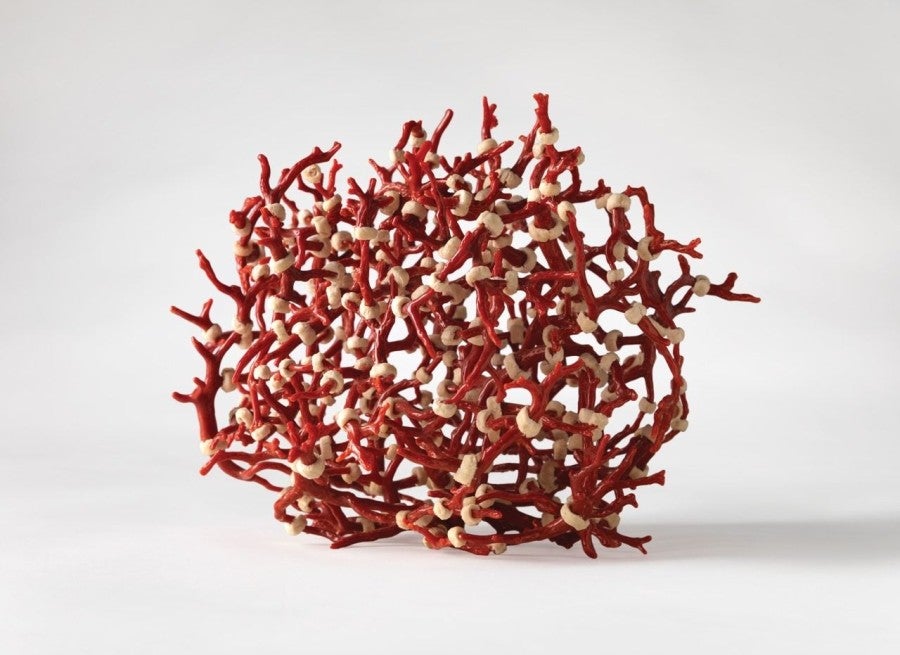
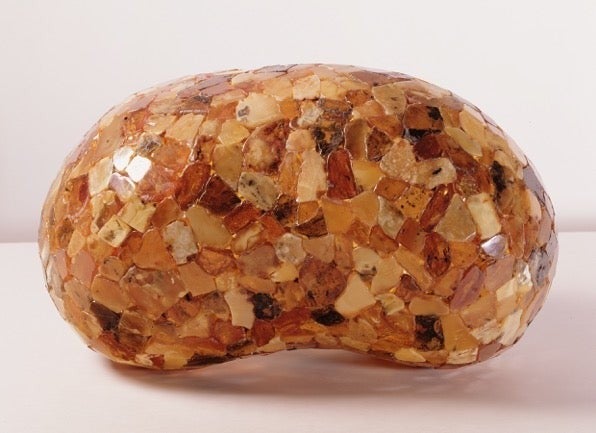
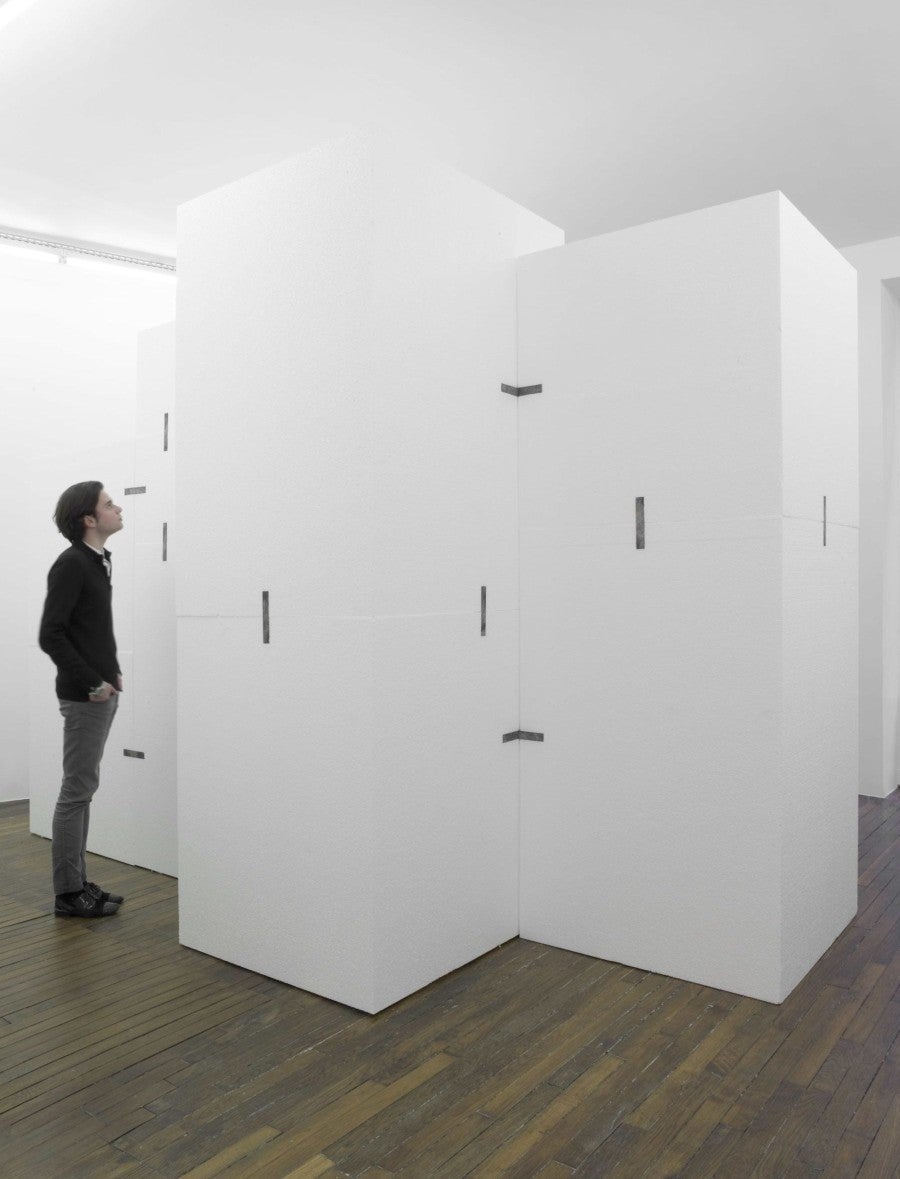
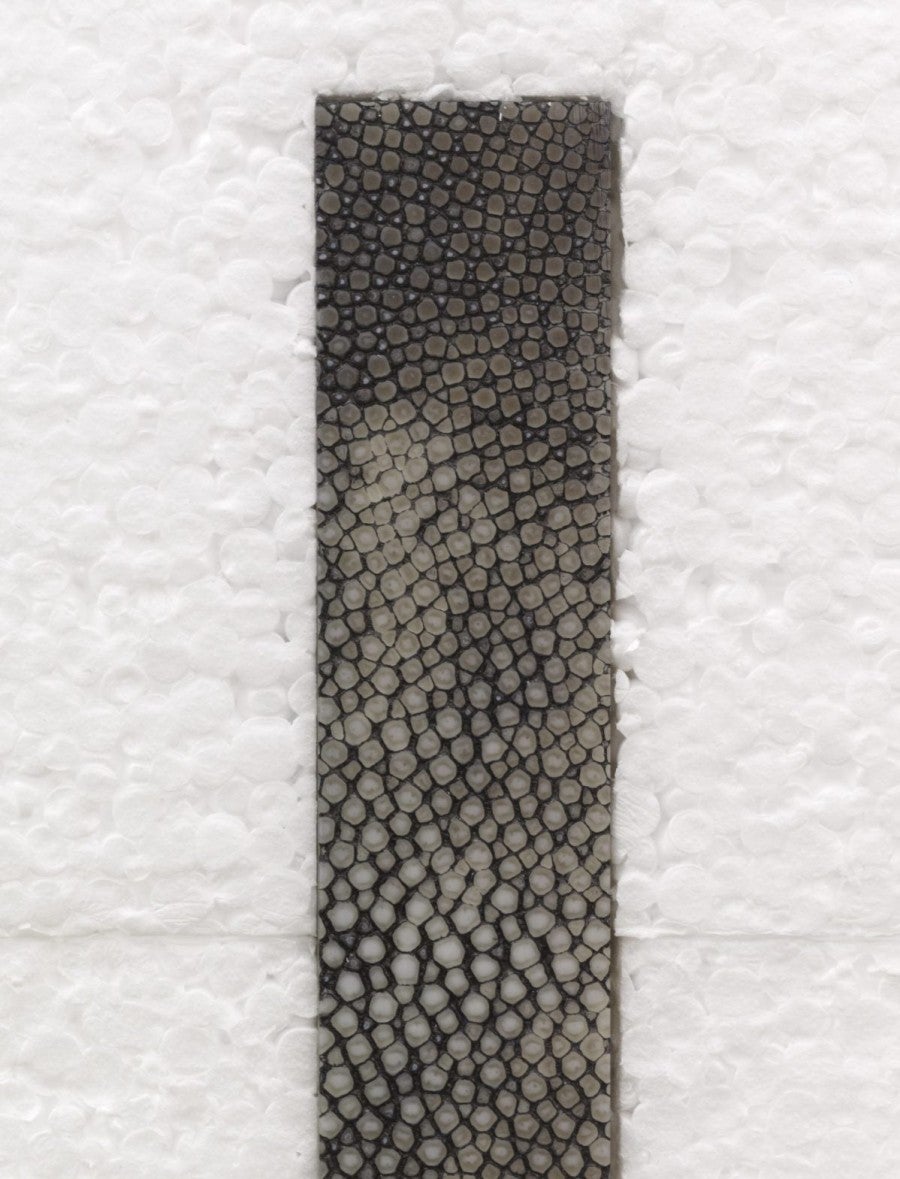
This would make for a rich, deeply humanist position, an enfolding one which values the multiplicity of textures within the natural world and the ability of even extremely humble creatures, like worms (how much lower does it get?) to contribute to the whole. It does not, indeed, exclude melancholy associations regarding humanity’s blighting of the earth, but it is not contained by them. A signal quality of Duprat’s work is that it is not easily contained by any rubric; it’s extremely formal but open to accident, for example. For audiences who, again, like straightforward narratives, this can be an issue, hard to grasp, like standing unknowingly atop a giant, submerged rock. The first time I wrote about Duprat, for instance, I think I sold him short. I contained his work within a rhetorical framework that had to do with humanity’s estranged relationship to the natural world, one that had its own binaries: a desire for connection with nature, but a predilection for breaking it. This is relatively small, as a reading, and it fatally reinforces what we already know; it encodes it. Art’s job is not to do that. Art’s job is to move the goalposts, shift mental frameworks, engage the speculative.
3.
Let’s go back to Chagrin a moment. Merriam-Webster defines the word, punned on here, as ‘disquietude or distress of mind caused by humiliation, disappointment, or failure’. What might that mean, in such a context? Chagrin might thereby encode an ambient sadness concerning distinction and imposed difference. We’ve parcelled out culture so that sculptural minimalism sits over here, and the craft tradition over there. Are they both not ways of making communal, coded meaning through objects? Is the culture/nature distinction not equally dumb, given that we—humans, culture-makers—are also part of nature? Caddisflies can make objects too; and they can, if nudged, make objects that read to us as art. In Both Root and Fruit (1997–8), Duprat couched his aversion to binaries in the very title of his work. Here, a branching wooden form has been intricately covered with nailed-on squares of cow bone: in other cultures, this would be a traditional form of decoration and involve ivory, though for obvious reasons Duprat abjured that option. In what sense this is ‘fruit’ is unclear, but one might perhaps interpret the title as meaning the form is both fecund and the outcrop of fecundity; or that we have here the cause of something—the wooden root—and the result, the artwork. What’s also notable about it, from two decades’ distance, is how completely, superbly out of time the work looks.
Up close, Both Root… resembles, in its endless succession of white squares each featuring the dot of a single nail head, a succession of dice that have all landed the same way up. In an untitled work from 2011, Duprat combined a scattering of dice with soft-edged chunks of ulexite, a semi-opaque crystal also known as ‘TV rock’ for its capacity to transmit an image, via light travelling along its fibres, of whatever is behind it onto its opposite side. Untitled has geometry, in the form of the dice, and chance, also in the form of the dice, and more apparent chance in the pileup of crystals. The latter are haphazardly shaped but deep within them, crystallography tells us, is some highly functional geometry. Ulexite sits in the ground, in various parts of the world where its key ingredient, boron, resides. As with many of the materials Duprat works with, it can be viewed as a wondrous thing: as usual with him, this wonder isn’t limited to the organic, the natural. Plexiglas, as we’ve seen, has impressive optical properties if treated right.
In Tribulum (2012–3), Duprat took a green rectangle of polyurethane florist’s foam, a thoroughly man-made material designed to frame real nature; embedded it with myriad vertical flakes of knapped flint looking like brown wavelets; and stood this object on one end, the result halfway to abstraction as Duprat’s works often are. This one, again not atypically, scents of the present and of deep time. Knapping flint, shaping it into tools and handcrafts, has been essential to the survival and sophisticating of the human race, and, grimly, via the flintlock gun, to its darker hours. Knapping is a process that endures in some areas, including, apparently, Brittany and Normandy, and one might see part of Duprat’s process as preservation of tradition. (At the same time, he’s not a sentimentalist or a luddite. All these processes coexist, for him, with scientific methods; indeed, a long time ago they were science.) In Beasts (1992–9), Duprat took pieces of flint and carved them into animal shapes: pointedly, though, they resemble not only animals but human hands shaping themselves like animals in order to enact shadow-plays. The result, activated by the passage, the casually amazing physics of light as Duprat’s works frequently are, unites the human, the mineral, and the natural, and operates in the present while harkening to the deep past.
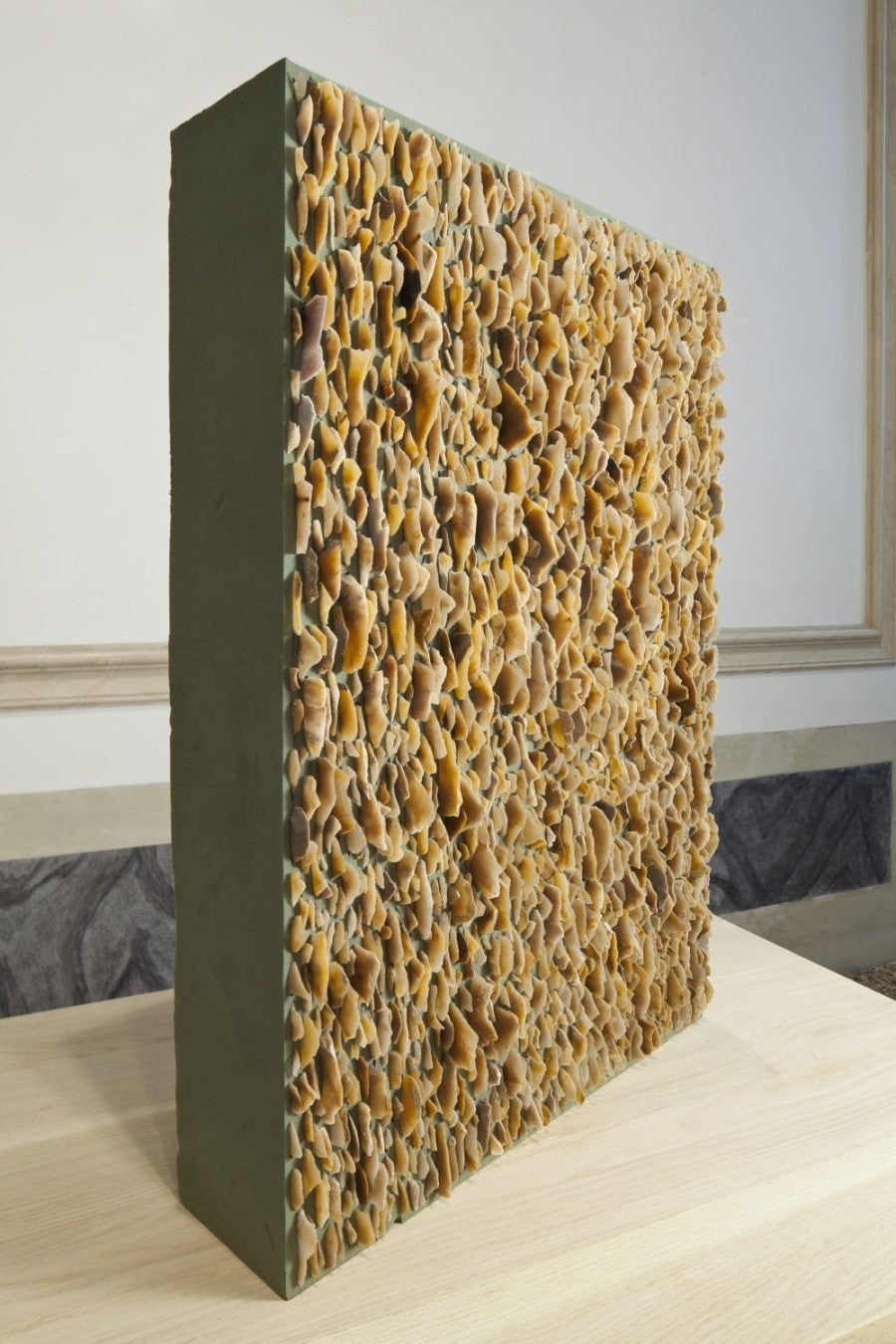
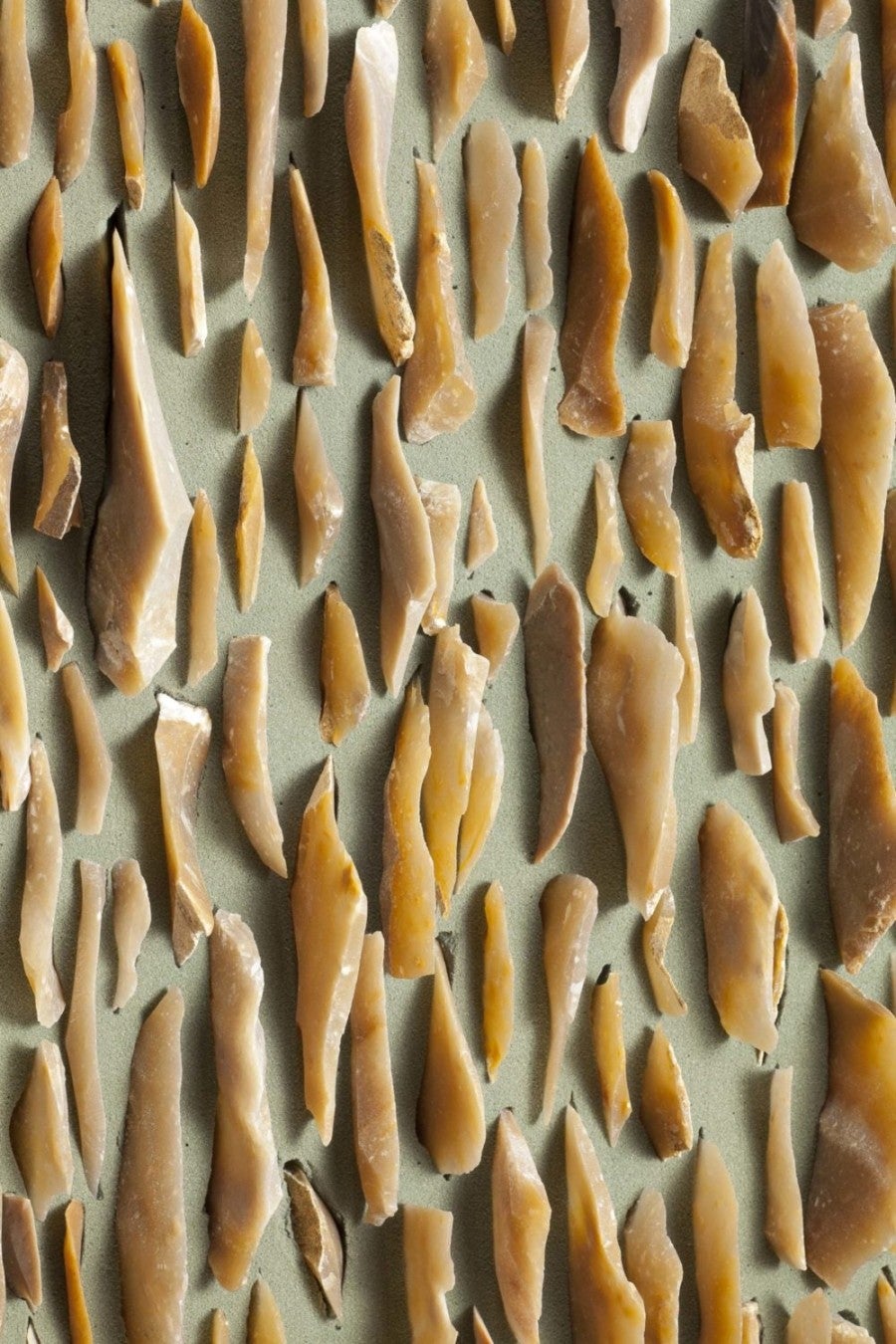
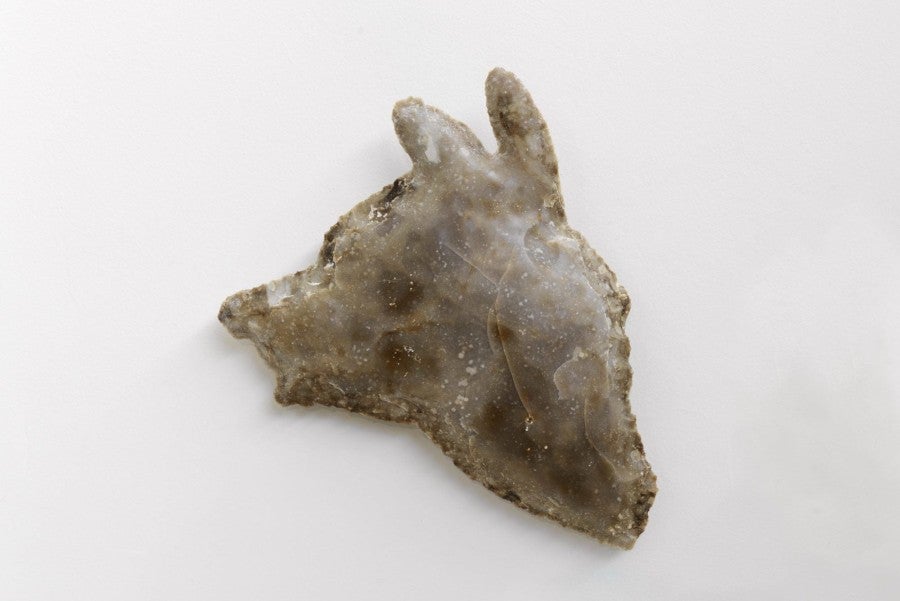
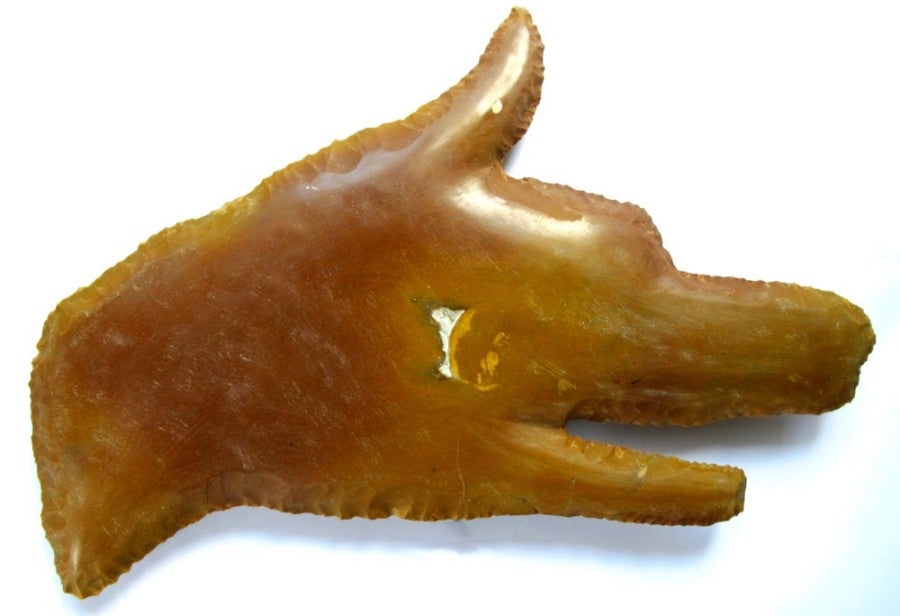
...a mineral history and a human one, the two bound up together.
The existence of flint deposits, and the fact that our ancestors found them, is a miracle of sorts. It’s the far end of the long tail of technology, and pulling materials out of the ground to deploy them for clever ends is still what we do. (Think of the ‘rare earth’ materials in smartphones; and of the exploitative labour used to extract them.) In North (1997–8), Duprat fashioned an uncanny globular, hollow form from flat-sided pieces of Baltic amber, glued together. Amber, of course, has long been used for decorative purposes; but it is also key to our understanding of what has lived and died on the earth, because amber has preserved them, particularly insects. It’s a database, and a material with geologic time built into it. When Duprat organises it into an aleatory composition, both the material fact and the haphazardness count. We could have not discovered flint, and now we wouldn’t be here, or we might be back where we were, progress-wise. We could have not discovered amber, and we’d know less about natural history. We could have chosen not to extract so heavily, and we might have a better chance of preserving life on earth. Janus-faced, again.
Pointedly, the chief recurrent form in Duprat’s oeuvre is the cylinder, or, since many of his cylinders are hollow, the tube. It’s typical that his key object should be doubled in aspect in this respect, both thing and emptiness; typical too that he should even elect to mess with this division. In an untitled work from 2007, he constructed a cylindrical form from glued-together pyrite crystals. It looks glitteringly sci-fi but it’s composed of ancient stuff—Pliny the Elder is considered to have written about pyrite, which is also called fool’s gold—and, like flint, it’s historically been used to fire guns. (In an untitled work from 1992, Duprat peppered a plaster wall with lead shot, like a frustrated alchemist.) For a further untitled work, dated 2008–13, he created another cylinder, upright this time, from Icelandic spar, or calcite, the rhombohedrons of crystal composed in rows wherein the angled rows of spar change direction each time. Now, Icelandic spar is no minor rock in the pantheon. It has the property of double refraction, so that objects seen through it appear to multiply, and, pointedly for Duprat’s light-filled practice, it was crucial to the understanding of light as a wave. Spar is, additionally, thought to have been used by Vikings as a ‘sun stone’ that would identify the location of the sun when it was obscured. This, then, is once again a mineral history and a human one, the two bound up together. If Duprat deploys chance, he doesn’t pick his materials chancily.
Why the cylinder, from Coupé-Cloué until the recent work of 2019? Why the line in space? It’s a model continuum; it also has an end. Go back to the recent Martyr, the Plexiglas tube with the holes, and the two ways of looking at it. You can look at the far extremity, the flat slice, and get one picture: the present, arguably, where all seems clear and unobstructed. Or you can stand at the side, look down the line and get a curving, twisting picture, the kind you might get when you only know some history, not everything (which means all of us). We need to keep both in mind. Our culture, today, is committed to a barrelling forward motion, thanks in no small part to the technological developments that, in the popular imagination, are synonymous with progress. Many human problems stem from forgetting the past. The bothness of Duprat’s work is operant on many registers: it equalises artist and bug, artist and craftsperson, artist and inventor/tinkerer in the Renaissance manner, culture and nature, the synthetic and the organic, past and present, artistry and ethnography, apocalypse and abstraction, order and chance, understanding and ambiguity, habitat and artwork, hollow tube and illusory white cylinders. Look at Volos (2013), a rectangle of orangey-brown clay wrapped in plastic, topped with a polished stone axe head—and also resembling an ancient figurative sculpture—and see millennia collapse before your eyes.
Duprat’s art is, in this regard, world-swallowing and time-swallowing, on a rare order of ambition. Indeed, one marker of major art is how much inference it can withhold, the answer here being: plenty. But if this practice is chiefly directed somewhere, it may be towards a holism lit up by glimmering wonder, respect for what surrounds us and what’s gone before, and the disposal of humanistic hierarchy. Its maker has no interest in putting up conceptual fences because he wants to remind us that nature, including stuff buried in the ground, is as miraculous and unknowingly beautiful as art and as essential to the human story, that insects deserve gold and gems to play with, that inventive humans have unravelled many mysteries with the same materials they’ve used to create weaponry. That there’s more to everything, if you dig. We ought to stand at the end of the tube, live in our moment, observe it closely, but also remember that we’re just the latest iteration in a very long story, parts of which are going to be forever unknown to our overconfident, technocratic selves. Of course, Duprat being the endlessly multifarious Duprat, his work doesn’t only say that. But such might be a worthwhile place to start; or, for now, to end.
See Maurice Fréchuret, ‘Both Root and Fruit’, in Hubert Duprat, Musée Picasso, Antibes; MAMCO, Geneva; Frac Limousin, Limoges, 1998, p. IV–XV.
